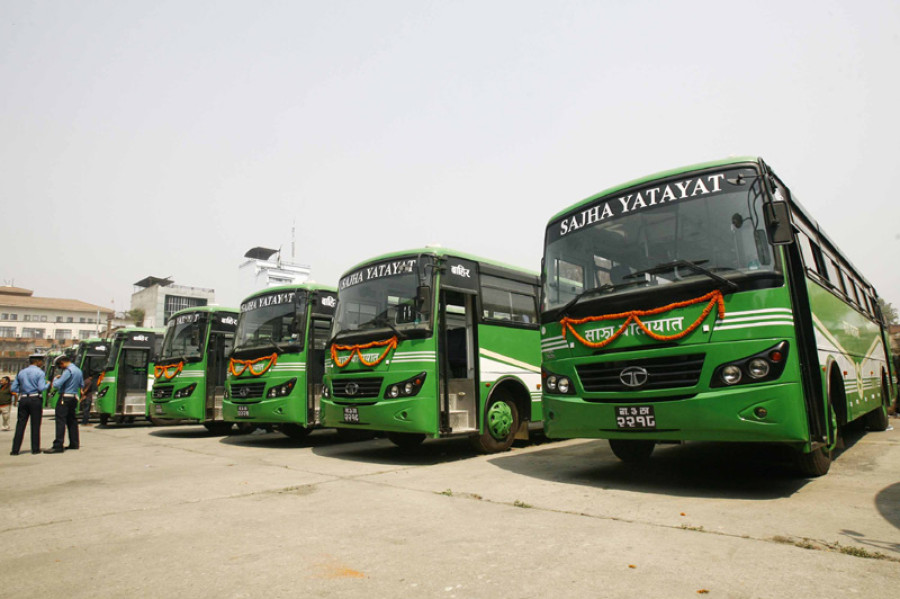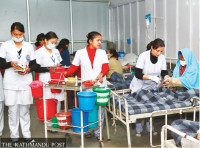Miscellaneous
Year Ender 2016: The bus is back
Good old Sajha Yatayat expands with renewed vigour in a new avatar
Anup Ojha
Sajha bus ma jo pani chadachha; Cilinder le dwi rupeko ticket katdachha’
This song about the Sajha bus was an instant hit during the early 1990s, and it reminds us of the time when these green coloured vehicles were everyone’s favourite means of transportation both inside and outside the Kathmandu Valley. The lyrics to the song, composed and sung by reputed comedian Hari Bansha Acharya, illustrate the pathetic situation the bus service was going through at that time. Acharya remembers how Sajha was the leader of the Valley’s public transportation system during his childhood.
“Sajha Yatayat was the only means of transportation as very few other public vehicles were available in the Valley.” He added that the all-time favourite Sajha was ruined by bureaucratic corruption. He also remembers how Sajha buses used to ply in the city even during times of Nepal banda and were targeted by demonstrators. “Those who broke the windows of Sajha buses even built new homes in Kathmandu,” says Acharya sarcastically. He said that he was inspired to compose the song, which was picturised in the Nepali movie Filim, after seeing Sajha’s pathetic situation. “I have seen that nothing has succeeded when our government starts to work on its own,” says Acharya.
Sajha Yatayat went out of business in 2001 after operating buses in various parts of the country for nearly four decades. It is learnt that the drivers, conductors and officials associated with Sajha earned a lot of money by selling parts due to lack of strict monitoring by the government and because of the involvement of government officials in the misdeeds.
Sajha Cooperative was established on March 16, 1962 under the Cooperative Act and involved government officials, various organisations and the public. Bishwa Bandhu Thapa was the founding chairman and Krishna Bom Malla, Juddha Bahadur Shrestha, Dev Jyoti and Bishwanath were the founding executive members. On July 16, 1962, four months after being established, Sajha began urban transport services in the Valley. In 1980, the government of Japan gifted 35 Isuzu buses. Six years later, the government provided 47 additional Mitsubishi buses to Sajha, including equipment. The government also set up a repair workshop and a new building. In 1993, Sajha got another 35 Tata buses using the loan trust distribution fund. However, due to lack of strict monitoring, financial irregularities and weak administration, Sajha Yatayat started to unravel. In 2001, the Cabinet dissolved the organisation.
Sajha got a new lease of life on January 29, 2003 after the Appeals Court Patan scrapped the Cabinet’s decision to shut it down. Two shareholders, Shyamdas Shrestha and Bhadra Kumari Ghale, had appealed to have the Cabinet decision annulled. A year after, on May 14, 2004, Sajha resumed services in Pokhara, Bhairahawa, Birgunj and Kalaiya. It also extended its routes to Palpa, Taulihawa, Baglung, Beni and Gorkha. On May 1, 2005, Sajha signed an agreement with China and started bus services between Kathmandu and Lhasa. It also operated services between Kathmandu and India. At about the same time, Sajha started operating 50 buses on the Ring Road. However, this didn’t last very long. Again due to political instability and increasing corruption, the organisation ground to a halt.
Currently, Sajha Cooperative has 46 buses in its fleet and employs 190 people. In 2013, Sajha bought 16 buses meeting Euro III emission standards and having a capacity of 55 seats from India at a cost of around Rs58.3 million. These buses ply two routes. They are fitted with CCTV cameras and automatic doors and gave much relief to passengers who were compelled to ride in small and crowded vehicles. Sajha Yatayat has won the hearts of Kathmanduites with its punctuality, fair ticket prices and uninterrupted service even during shutdowns. Travellers have praised Sajha for providing bus services on long routes during the Dashain festival when bus tickets are hard to come by due to the rush to return home for the celebrations.
On November 28, the cooperative brought in 30 additional, disabled-friendly buses to ply on four different routes in the Valley. The service was inaugurated by Prime Minister Pushpa Kamal Dahal who took the bus to reach his office at Singha Durbar. These buses cost Rs3.5 million each. Kathmandu Metropolitan City has invested Rs100 million as its share. The 40-seater buses, manufactured by Ashok Leyland of India, have ample standing room in the aisle. Each bus can accommodate around 100 passengers.
Since Dashain last year, Sajha Yatayat has been providing services to Bhairahawa, Gorkha, Lumbini and Baglung. Meanwhile, it is also planning to bring one semi-low floor bus and 10 deluxe buses. The semi-low floor bus allows children, the elderly and the differently-abled to get on and off with ease. It will operate in Kathmandu only, while the 10 deluxe buses will operate on long routes, according to Mahendra Raj Pandey, acting chief executive officer of Sajha.
In a bid to provide better services to passengers and make operations more transparent, Sajha is planning to introduce a multipurpose e-card system on all its 46 buses. This will be a first in Nepal’s transportation history. Pandey said that Nepal Bank had assumed the responsibility for managing the cards which will cost Rs250 each. He added the cards could also be used at department stores, restaurants, banks and movie halls as well. Travellers will pay the bus fare by swiping the card at the door. Pandey said that the card system would be a great relief for both passengers and Sajha as it will eliminate chances of being cheated by the bus conductor. He added that 40 conductors had been fired so far for financial wrongdoing.
All in all, 2016 was a reinvigorating year for the iconic Sajha bus. The sight of the green buses approaching at a distance is no doubt a relief for the denizens waiting for transport to and from home, particularly during the office “rush hours.” And with the co-operative plotting further expansion in the future, 2017 should be a year when the beloved Sajha moves from strength to strength.




 20.12°C Kathmandu
20.12°C Kathmandu.jpg)










